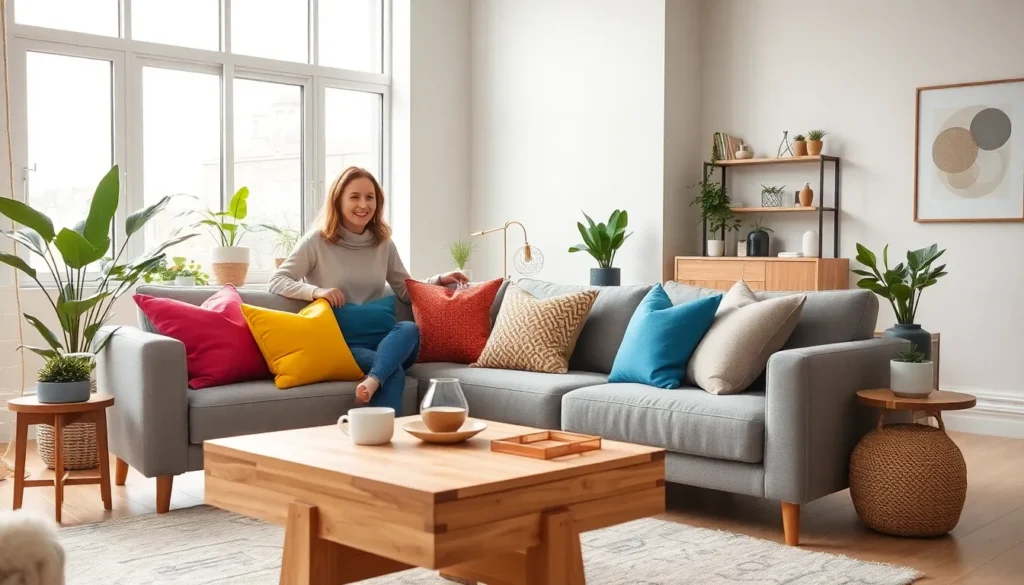When it comes to design, the world is a playground brimming with creativity and inspiration. Whether it’s a sleek website, a chic living space, or a captivating logo, design concepts are the secret sauce that can turn the mundane into the extraordinary. Everyone loves a good makeover, right? Just like that one friend who suddenly got a haircut and now looks like a movie star, design concepts can transform ideas into visual masterpieces.
Table of Contents
ToggleOverview of Design Concepts
Design concepts serve as foundational ideas that guide the creative process across various disciplines. Each concept brings unique characteristics, influencing the functionality and aesthetic of the final product. Minimalism emphasizes simplicity, focusing on essential elements without distractions. This approach often uses clean lines and a limited color palette to create a sense of calm.
Another prevalent concept is maximalism, which embraces complexity and abundance. This concept showcases vibrant colors, intricate patterns, and diverse textures. The result offers a rich visual experience that invites exploration and engagement. In contrast, sustainable design prioritizes environmentally friendly practices and materials. It aims to reduce waste and minimizes ecological impact, ensuring longevity and resilience.
User-centered design focuses on tailoring products to meet the needs of specific audiences. This concept integrates user feedback throughout the development process, leading to more intuitive interfaces and functionalities. Furthermore, adaptive design addresses varying device requirements. By ensuring compatibility across multiple platforms, this concept enhances user accessibility.
Experiential design emphasizes creating immersive experiences. It involves engaging the audience emotionally and physically, transforming ordinary interactions into memorable moments. Additionally, brand identity design encapsulates the visual elements that communicate a brand’s essence. Logos, typography, and color schemes become crucial in conveying values and mission.
Research shows that strong design concepts enhance user satisfaction. Clarity and coherence in these concepts improve functionality and make products more appealing. Designers who effectively utilize these principles can create impactful solutions that resonate with users, resulting in a lasting impression in various domains.
Types of Design Concepts

Design concepts can be categorized into various types, each serving specific purposes in the creative process. Understanding these types enhances the effectiveness of any project.
Visual Design Concepts
Visual design concepts focus on aesthetics and the visual impact of a project. Elements like color, typography, imagery, and layout play critical roles. Color schemes evoke emotions while typography sets the tone for communication. Imagery provides context and enhances storytelling, and layout organizes information for clarity. Specific trends such as flat design emphasize simplicity and functionality, while gradients add depth. Strong visual design can significantly improve user engagement and brand recognition.
Functional Design Concepts
Functional design concepts prioritize usability and efficiency. User experience drives decisions in this category, focusing on intuitive navigation and accessibility. Elements such as responsive design ensure compatibility across devices, enhancing user interaction. Task-oriented layouts streamline workflows, while feedback mechanisms inform users about their actions. Prioritizing functionality leads to products that not only look good but also perform effectively, addressing user needs seamlessly.
Notable Examples of Design Concepts
Design concepts manifest vividly across various fields, offering innovative solutions that enhance experiences.
Architectural Design Examples
Architecture showcases creativity at its finest, combining functionality with aesthetics. The Sydney Opera House exemplifies this blend through its iconic sails. The Guggenheim Museum in Bilbao features curvilinear shapes, redefining traditional architectural forms. Sustainable buildings like Bosco Verticale incorporate greenery, enhancing urban environments. Each structure demonstrates how thoughtful design improves both visual appeal and user experience.
Graphic Design Examples
Graphic design continually evolves, responding to cultural shifts and technological advancements. The iconic Apple logo exemplifies simplicity and brand recognition, allowing instant association. Posters from the Bauhaus movement showcase geometric shapes and primary colors, making impactful visual statements. Recent trends include minimalistic web design which enhances user interface interactions while maintaining clarity. These examples highlight the importance of striking visuals and effective communication in graphic design.
Product Design Examples
Product design merges form and function, creating solutions that address user needs. The Nest Thermostat features a sleek interface that promotes energy efficiency while enhancing user interaction. IKEA’s flat-pack furniture emphasizes practicality and accessibility, making it easy for consumers to assemble. Wearable technology like the Apple Watch combines fashion with functionality, appealing to modern lifestyles. These products illustrate how innovative design improves everyday experiences.
Importance of Design Concepts in Various Industries
Design concepts play a crucial role across different industries, influencing everything from user engagement to brand perception. In the technology sector, user-centered design enhances product usability. It focuses on meeting end-user needs through intuitive interfaces, which elevate user satisfaction.
Architecture benefits significantly from effective design concepts. Structures like the Sydney Opera House exemplify the harmony between aesthetic appeal and functionality. Sustainable buildings, such as Bosco Verticale, showcase how thoughtful design can address environmental concerns while providing practical urban solutions.
Graphic design also relies on impactful design concepts. Iconic visuals, including the Apple logo and Bauhaus posters, illustrate how cultural movements shape design language. These elements create emotional connections that resonate with audiences, reinforcing brand identity.
In product design, concepts prioritize seamless user experiences. Innovations like the Nest Thermostat highlight how form and function can enhance everyday life. Flat-pack furniture from IKEA demonstrates efficiency in both design and usability, making quality products accessible.
The fashion industry incorporates design principles to express creativity and identity. Designers utilize color, texture, and silhouette to create collections that communicate themes and narratives. This approach transforms garments into wearable art, elevating the consumer experience.
Overall, design concepts across these fields foster innovation and drive progress. They shape perceptions, simplify interactions, and create memorable environments. Each application reveals the significant impact that thoughtful design has on enhancing user experiences and meeting diverse needs.
Design concepts play a pivotal role in shaping experiences across various fields. By understanding and applying different approaches, designers can create solutions that resonate with users on multiple levels. Whether it’s through minimalism’s clarity or maximalism’s vibrancy, each concept offers unique benefits that enhance functionality and aesthetics.
The examples discussed highlight how thoughtful design transforms ordinary spaces and products into extraordinary experiences. As industries continue to evolve, the importance of innovative design concepts remains undeniable. Embracing these principles not only elevates user satisfaction but also fosters a deeper connection between brands and their audiences. Ultimately, the impact of effective design is profound, leaving a lasting impression that transcends the visual.









